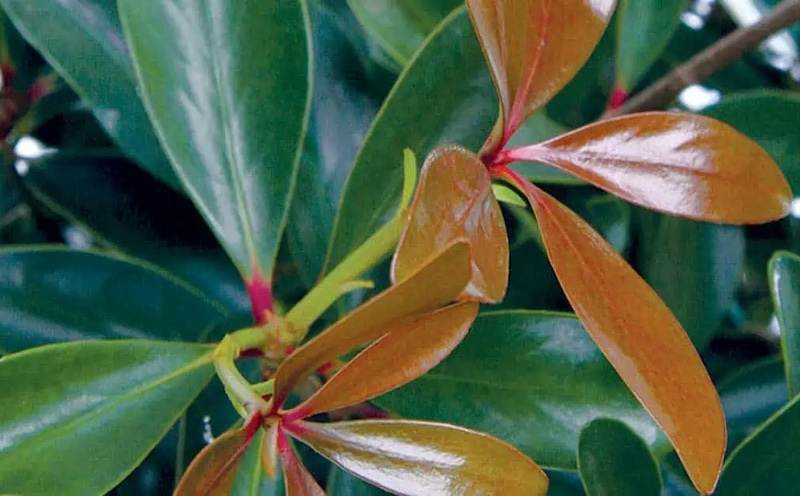Ternstroemia gymnanthera is a brilliant broadleaf evergreen shrub that seems to be absolutely impervious to many common garden diseases. This shrub is so disease resistant that it has become a recommended replacement for other more susceptible ornamental shrubs such as Photinia, Boxwood, and Leyland Cypress.
Cleyera is best suited for growing in part to full shade, especially in the hottest growing zones of 9-10. Growing Cleyera in full sun often results in a scorching or burning of the leaves, which can resemble some fungal or bacterial diseases. The one giveaway that your shrub has been burned by the sun and not attacked by a pathogen is if the damage is on newest shoots at the end of branches. Fungal and bacterial infections typically attack the oldest and weakest leaves of the shrub. One fungal disease that may be an issue for Cleyera is leaf spot. It can appear during the active growing period and spread quickly to the rest of the plant.

Fungal Leaf Spot
Cercospora spp. is more commonly referred to as fungal leaf spot and can infect many different types and varieties of plants. Cleyera grown from seed appears to be more susceptible to the leaf spot fungus. Symptoms appear as dark spots seemingly random on the surface of the lower leaves during mid- or late winter. As the weather warms, the fungus spreads and the spots become more purple and larger, spreading across whole leaves. Badly infected leaves fall off the plant. The infected leaves spread spores when plants are watered from above or when water splashes off of fallen leaves on the soil. Shrubs can recover if the problem is diagnosed and treated early. Untreated shrubs may lose all of their lower leaves and experience stunted growth.
Treating Fungal Leaf Spot
Leaf Spot is spread easily during periods of warmth and high humidity. Overhead watering of plants spreads the spores from plant to plant, helping them get a foothold on leaves that stay wet for extended periods. Because Leaf Spot rarely kills the Cleyera shrub, chemical controls are not often recommended. Cultural controls and mechanical treatment are the most effective ways to control a leaf spot outbreak.
Good hygiene in the fall is important to the health of any evergreen shrub. Diseases overwinter in infected leaves on the soil, so make sure to clear them away and dispose of them in the trash. Do not compost leaves with a fungal infection. Home compost piles rarely reach high enough temperatures to reliably kill off the fungal spores.
Watering at the appropriate time will keep Cleyera growing vigorously. Overwatering shrubs in a shady location will weaken their root system and make them less able to fend off a fungal infection. Cleyera planted in a garden bed must have excellent drainage. If the drainage has changed over time or is worse during the winter months, the shrub will need to be moved or the site drainage improved. Removing all of the infected foliage will help the plant recover faster. New foliage will emerge in the following season.
Do not be tempted to fertilize more than necessary during this period of regrowth. Encouraging quick regrowth may make the plant susceptible to sap-sucking pests such as aphids and scale insects.
Cleyera Disease Chart
|
Disease |
Identifying |
Treating |
|
Fungal Leaf Spot |
Older leaves with dark spots and yellowing |
Remove infected foliage from plants and the ground |
Sources: "Arkansas Plant Health Clinic Newsletter." University of Arkansas System Division of Agriculture. uaex.uada.edu
 |
Author Robbin Small - Published 4-26-2023 |
